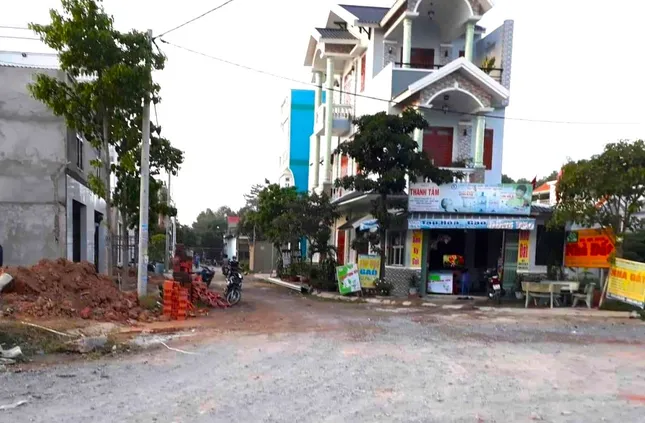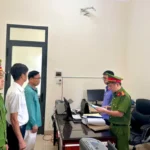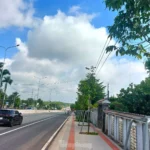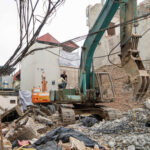As reported by Tien Phong journalists, the An Trung residential area (Tan Binh Ward, Di An City, Binh Duong Province) already has hundreds of old and new houses. Despite being labeled as a project, the electrical system is temporarily installed, and there is no drainage system in place.
An Trung Construction Investment Joint Stock Company (An Trung Company) received approval for the investment project of An Trung Residential Area from Binh Duong Province People’s Committee in 2006. Initially, the approved area was 19 hectares, which was later adjusted to over 11 hectares. In 2007, the Di An Town People’s Committee (now Di An City) approved the detailed planning at a scale of 1/500 of the project in Decision No. 3759. In 2012, the project was adjusted in the overall detailed planning in Decision No. 1135 (replacing Decision No. 3759).
With approximately 700 land lots, this area was once expected to become a new urban area and a highlight in Di An’s real estate development and planning. However, despite lacking the necessary legal documents and infrastructure construction, in 2014, An Trung Company proceeded to divide the land into lots and sell them to hundreds of customers in the form of “deposit contracts” and “investment cooperation contracts,” with prices ranging from VND 300 million to nearly VND 1 billion per lot.

Houses built without permits in the An Trung Residential Area project
Despite collecting money based on the value of each contract, the investors have not provided customers with land use rights certificates (pink books) for many years.
According to some residents, when signing the contract to purchase the land lots in the project, An Trung Company’s employees verbally committed that customers could build houses freely without permits, as the investor would guarantee it. Believing in this promise, many customers spent hundreds of millions of dong to build houses and have been living there for many years.
“More than ten years ago, I bought a land lot from someone who had purchased it earlier. The broker assured me that customers were allowed to build houses at their discretion. Up to now, neither the land nor the house has been registered, and I cannot mortgage it for a loan or sell it. I don’t know how long this house will exist, so we are very worried,” said Mr. N.D., a resident of the An Trung Residential Area.
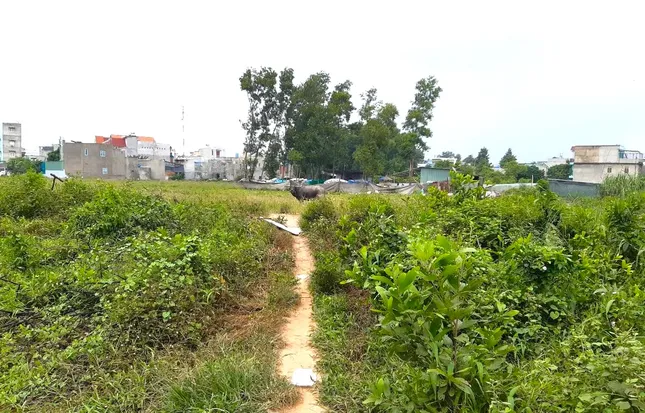
In the project, in addition to the hundreds of houses built without permits, the remaining area is vacant with overgrown grass.
Apart from Mr. D.’s family, there are hundreds of houses built without permits in this project. A representative of An Trung Company said that in 2006, after obtaining approval for the project, they started implementing it, but land clearance faced difficulties. Previously, the state supported compensation for the investor, but after 2010, according to new regulations, enterprises had to compensate by themselves, which caused difficulties for the company.
The investor’s representative affirmed that up to now, the project has not sold or transferred land lots but only cooperated with customers in investment.
Related officials are at large
According to the People’s Committee of Tan Binh Ward (Di An City), all the houses in the An Trung Residential Area were built without permits, and this situation occurred during the terms of two former chairmen of the ward. One of them is Mr. Nguyen Van Thien Dang, former Chairman of Tan Binh Ward People’s Committee and former Head of Di An’s Natural Resources and Environment Office, who is currently wanted by the Binh Duong Provincial Police after being prosecuted as a defendant for “violating land management regulations.”
Falling for ‘land brokers,’ hundreds of residents are stuck with problematic project land
|
Clip: Residents gather to put up banners and pressure the investor on Sunday (June 8, 2025) |
Regarding this project, the Department of Agriculture and Environment of Binh Duong Province said that up to now, the investor has not coordinated in determining the financial obligations to proceed with the procedures for granting land use right certificates.
Previously, in 2022, the People’s Committee of Binh Duong Province assigned the Department of Construction to coordinate with relevant units to consider the investor’s proposal to revoke the project’s policy, allowing the enterprise to implement it in the form of urban infrastructure improvement, complete tax obligations, and complete land procedures to consider granting land use right certificates to households that have received land lot transfers and 392 households that have received resettlement.
In 2023, the People’s Committee of Binh Duong Province assigned the Department of Construction to coordinate with departments, branches, and localities to inspect and report to the Steering Committee for consideration and resolution of projects with slow implementation progress, legal difficulties, and numerous complaints, including the An Trung Residential Area project.
In 2024, the People’s Committee of Binh Duong Province issued a document assigning the Department of Construction to coordinate with relevant units to inspect the progress of the An Trung Residential Area project to resolve the existing problems related to the project. However, the issues in the project have not been resolved so far.
The Great Land Scandal: Indictment of the Former Deputy County Chief Over ‘Red Book’ Issuance on Public Park-designated Land
“Authorities have taken action against the former deputy chairman of the district and a deputy head of the Department of Agriculture and Environment, following an investigation into the controversial allocation of land designated for a public park. The probe revealed that a 50-year land use certificate was issued to an individual, contravening the area’s designated purpose.”
A Scenic Drive: The Newly Expanded Highway Through Rubber Tree Forests Connecting Binh Duong and Tay Ninh Provinces
The DT744 highway, stretching from Binh Duong to Tay Ninh, has recently undergone a significant transformation. With a hefty investment of 2,000 billion VND, this route has been expanded from a four-lane to a six-lane highway, complete with a solid median and tree-lined sidewalks. One of its most striking features is the kilometers-long stretch that cuts through a vast sea of rubber trees, offering a unique and picturesque driving experience.
What Documents Are Required for a Red Book Transfer and Where Should They Be Submitted?
The process of transferring land and property ownership, or ‘red book’ as it is colloquially known in Vietnam, can be a complex and confusing task for many. It involves a number of steps and procedures that must be followed to ensure a smooth and legal transfer of ownership. So, what are the requirements and processes involved in this important procedure?
Binh Duong Recovers Land from Over 3,000 Households to Facilitate Crucial Infrastructure Projects, Enhancing Connectivity with Ho Chi Minh City and Neighboring Provinces
“The impact of progress: The upcoming construction of two major highways, the TP.HCM – Thu Dau Mot – Chon Thanh expressway and Ho Chi Minh City’s Ring Road 4, is set to affect the lives of an estimated 3,100 people in Binh Duong province. This figure stands as a reminder of the far-reaching consequences of infrastructure development and the intricate process of balancing progress with the wellbeing of communities.”
“Important Considerations for Land Transfer in 2025”
“Article 45 of the Land Law 2024 outlines the conditions for exercising various rights pertaining to land use, including conversion, transfer, leasing, inheritance, and mortgage. It provides a comprehensive framework for individuals and entities to understand and navigate the legal intricacies involved in land-related transactions and ensures a transparent and equitable process for all parties involved.”

